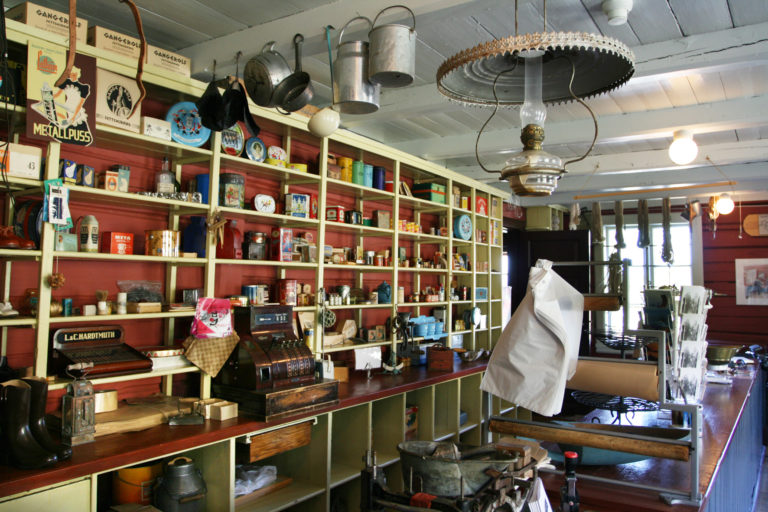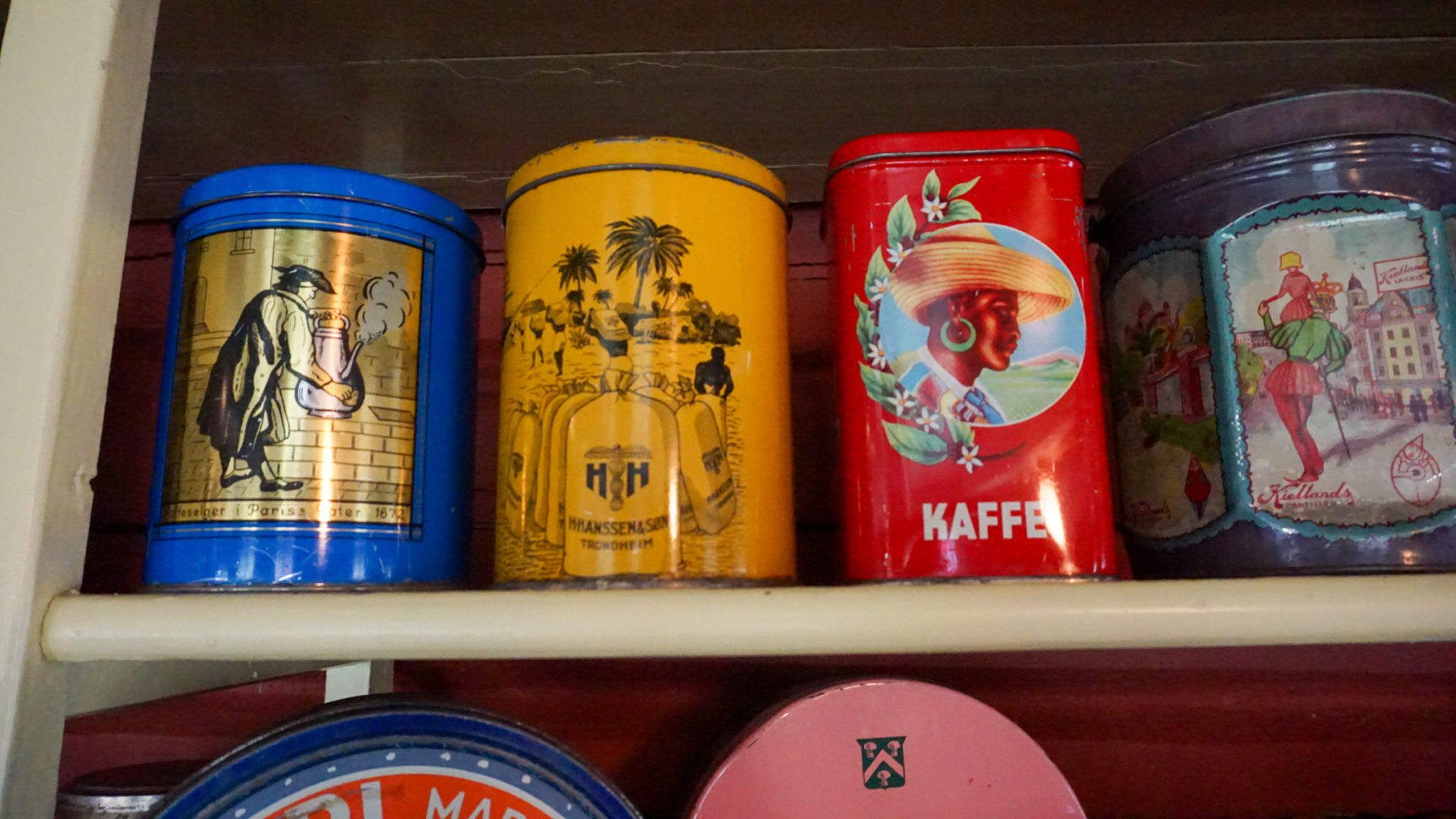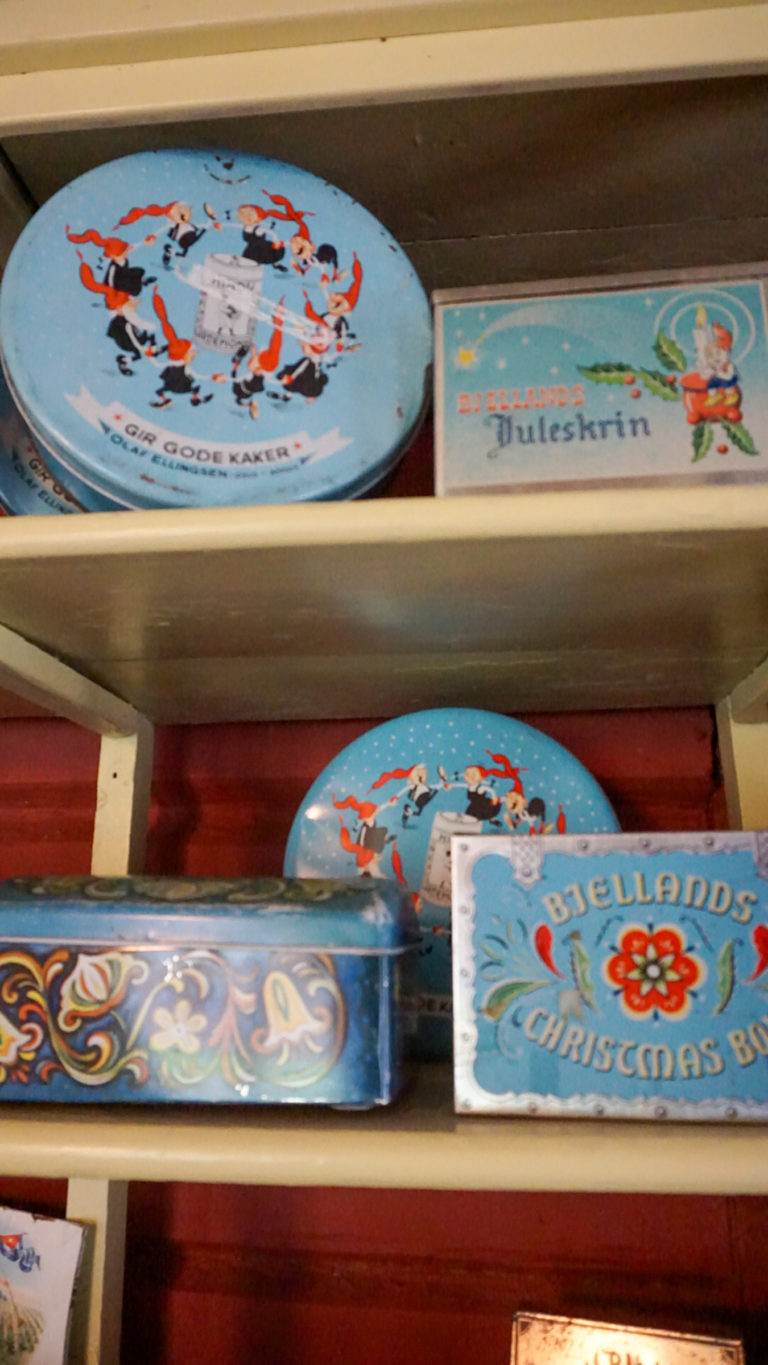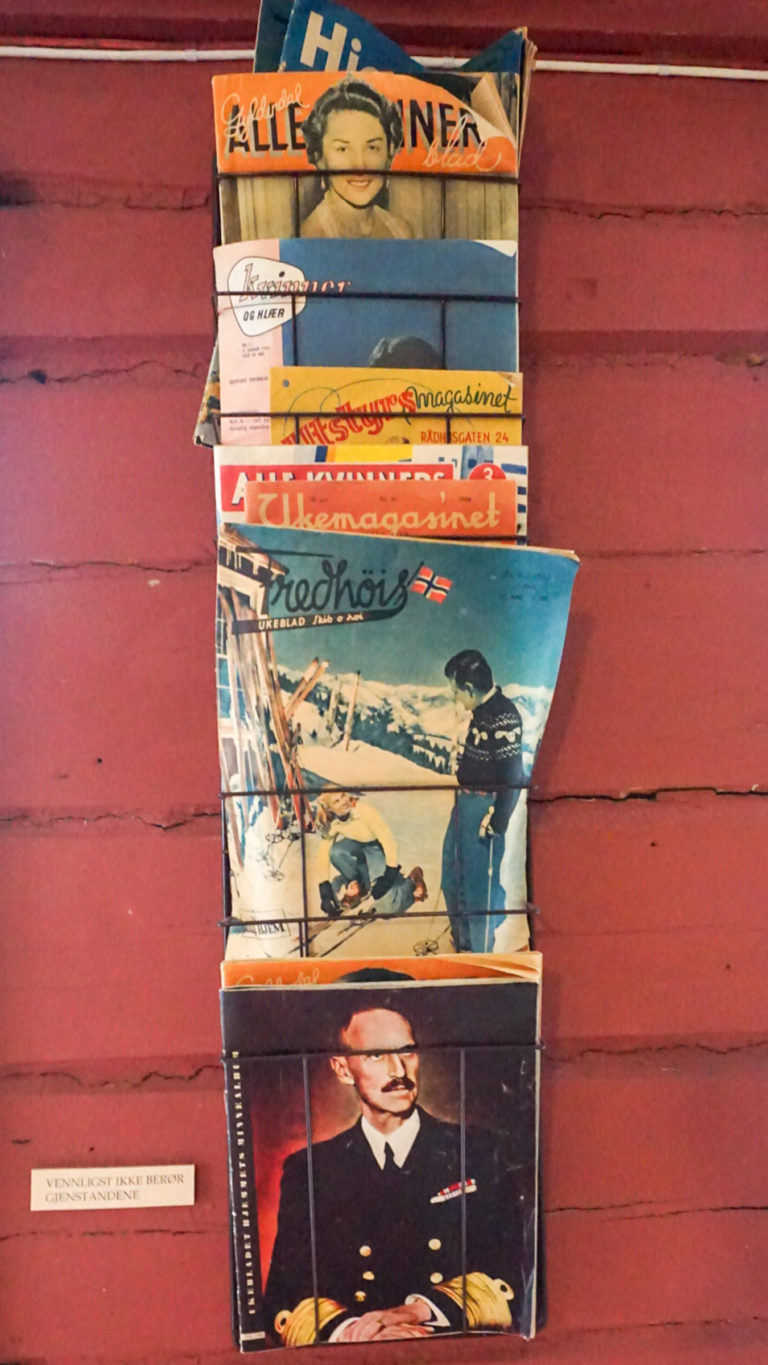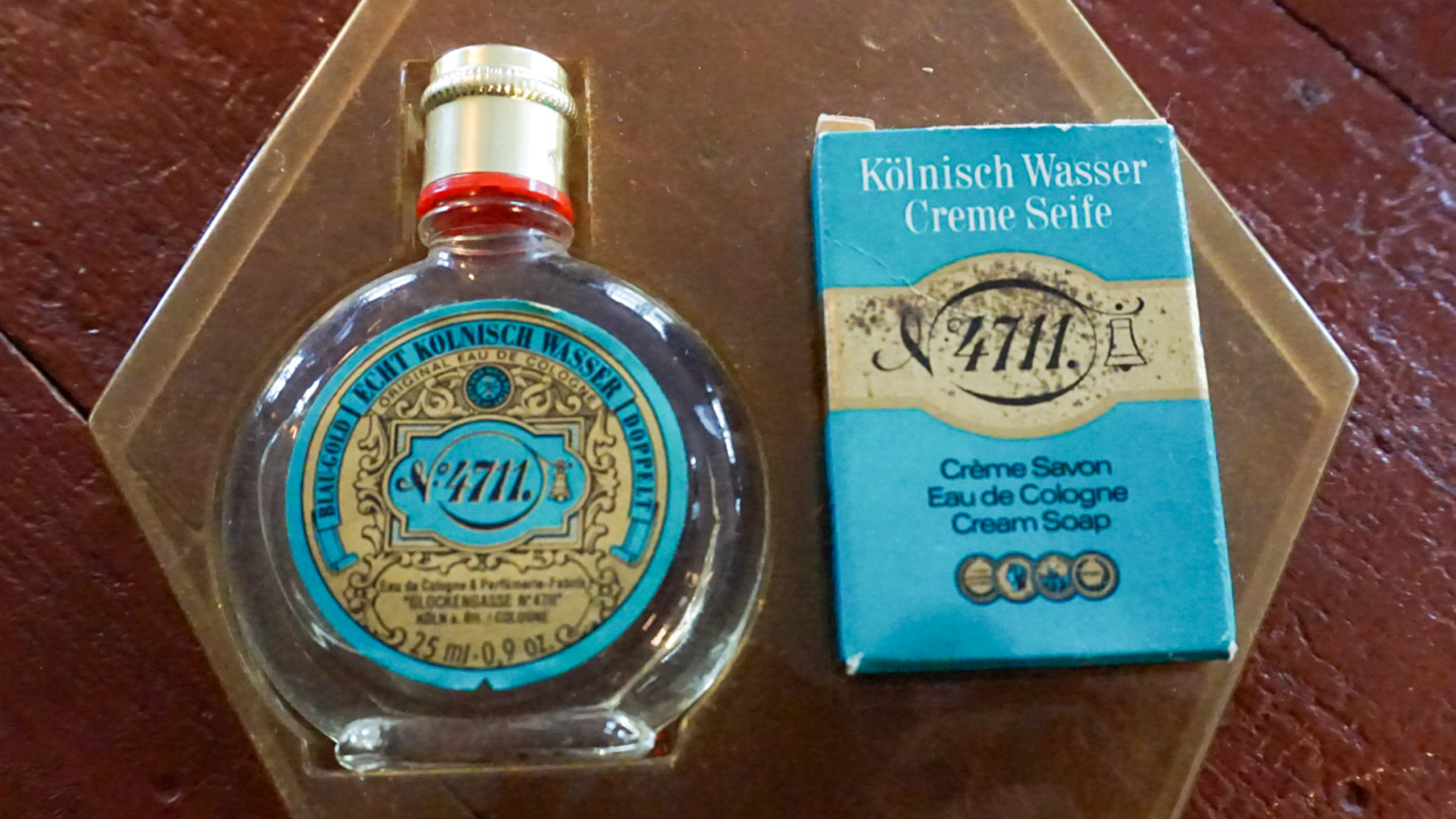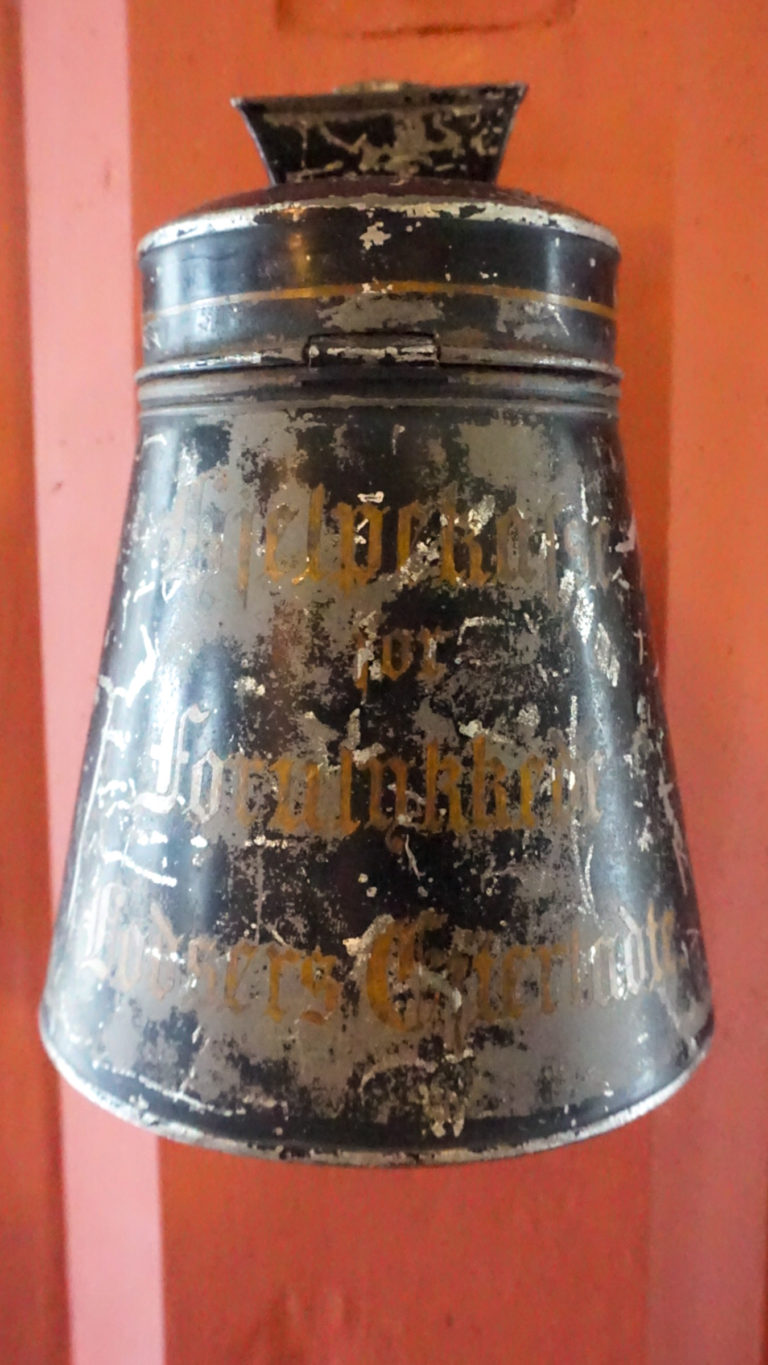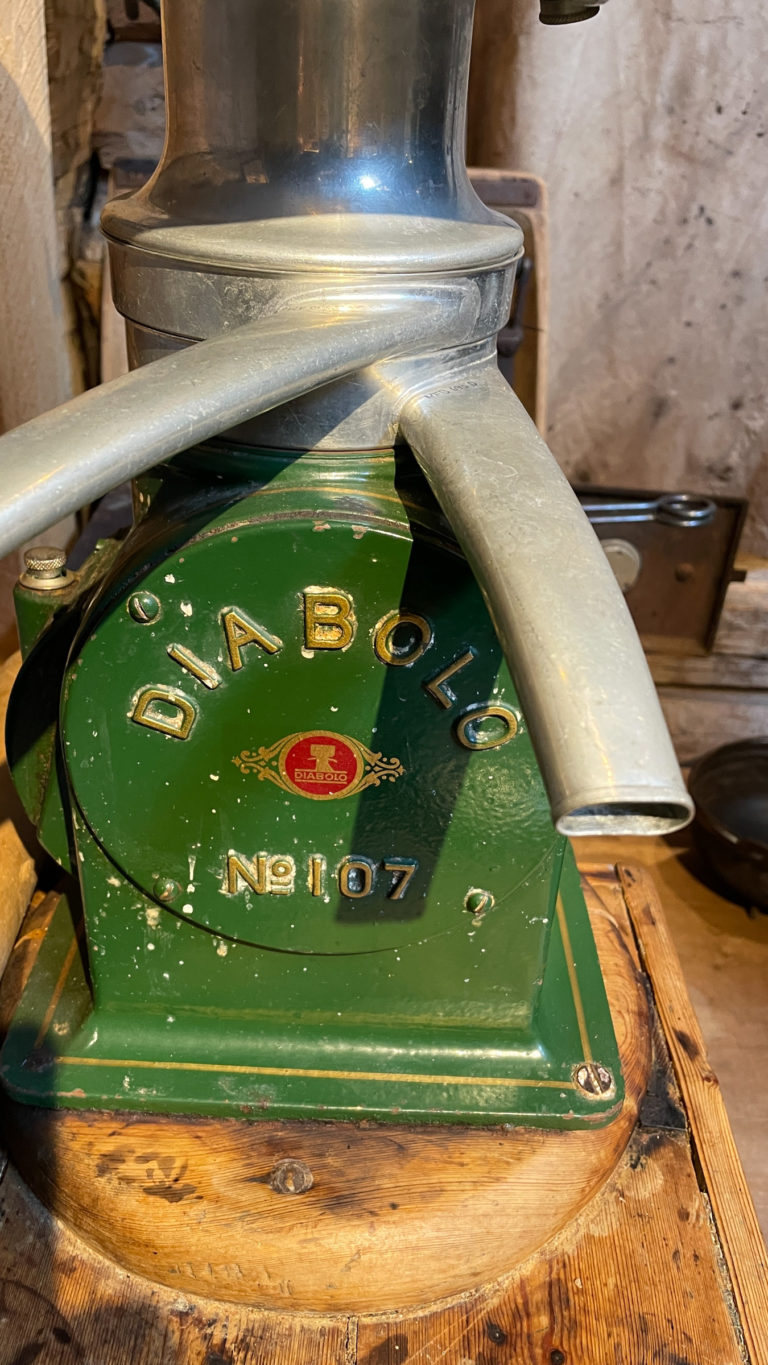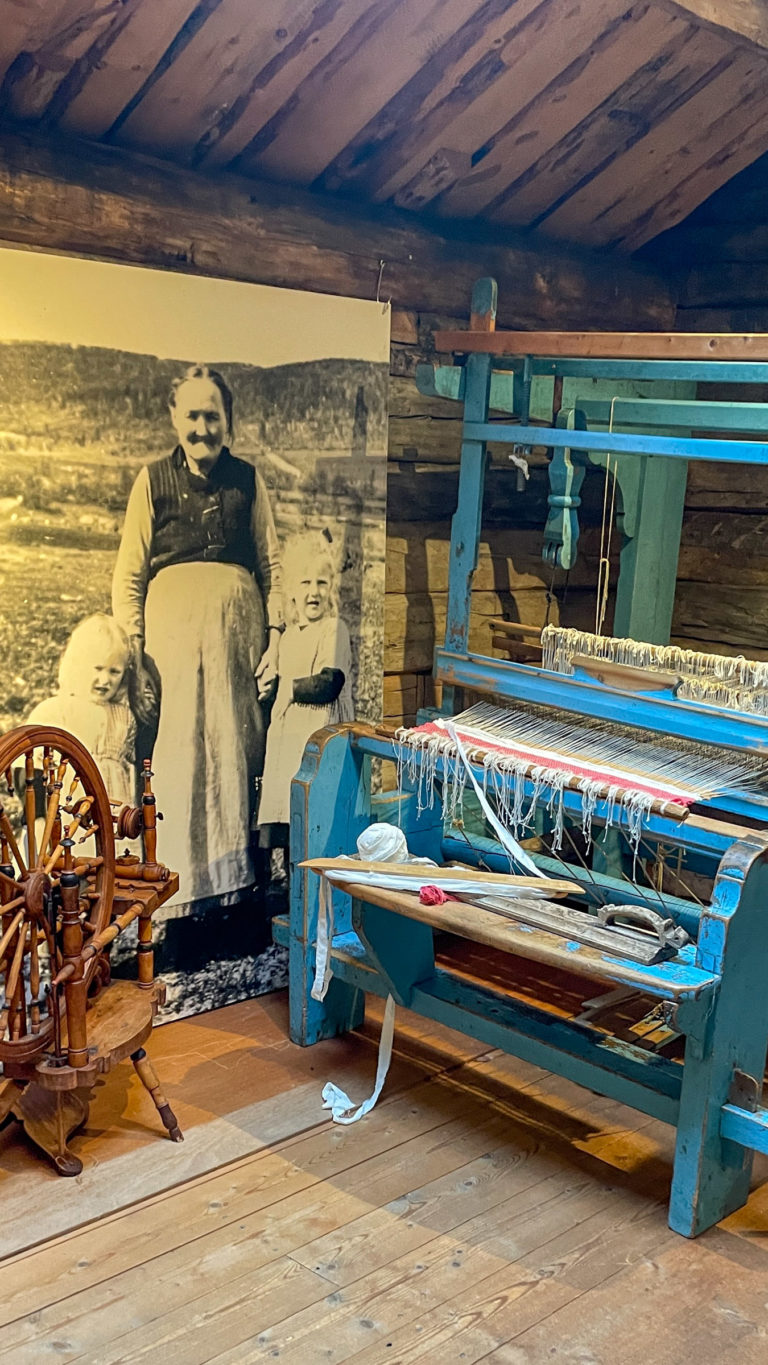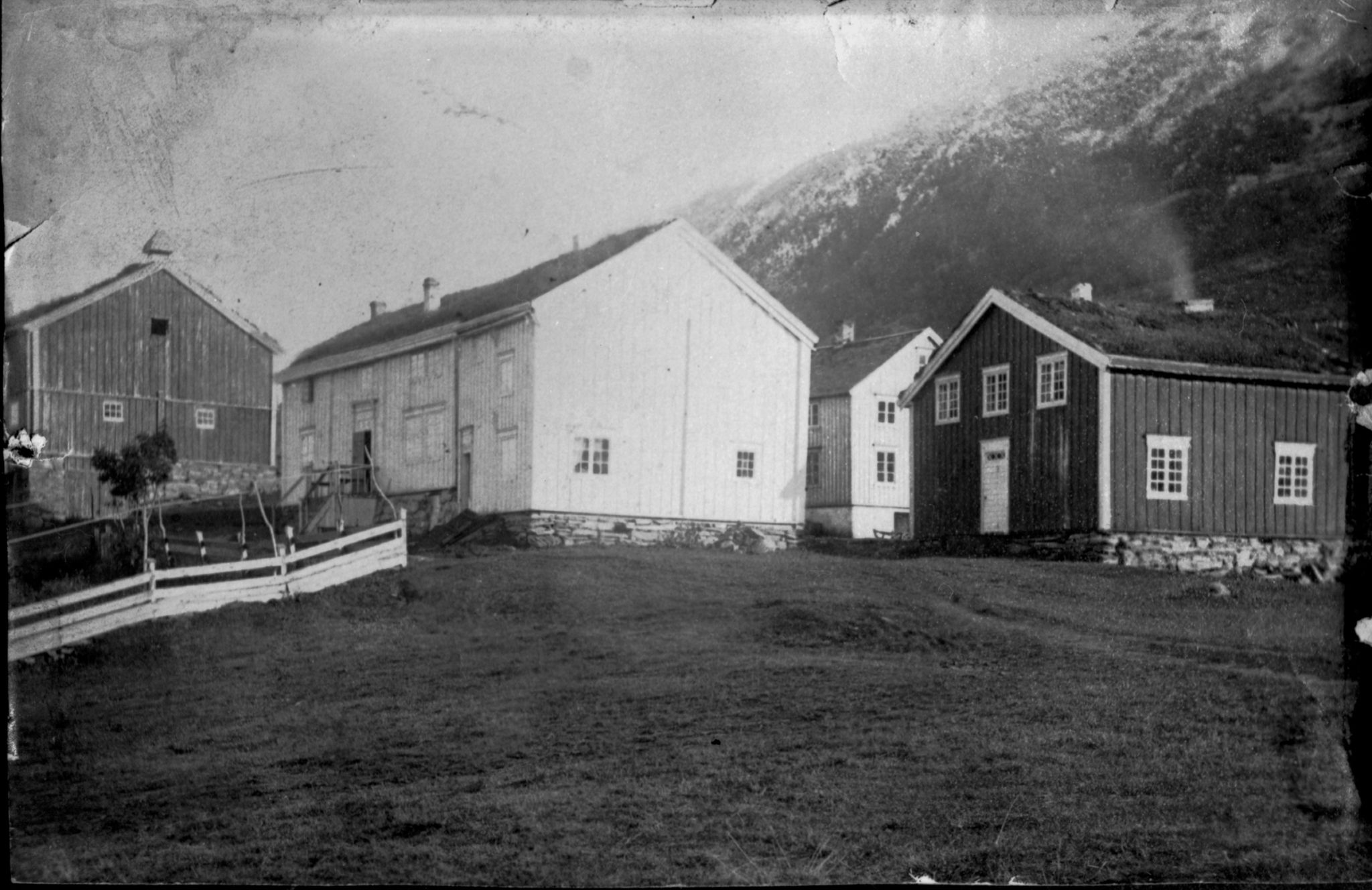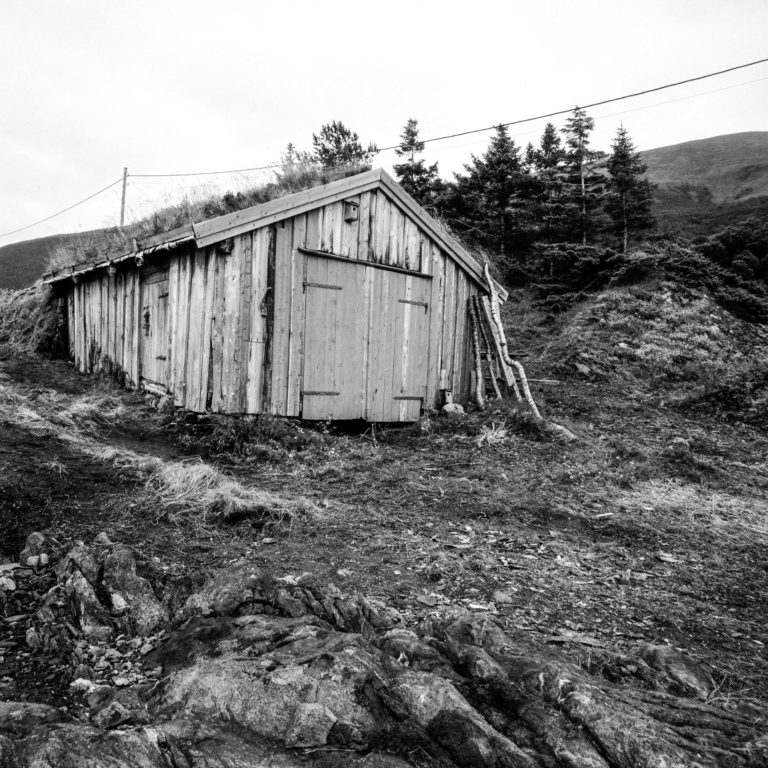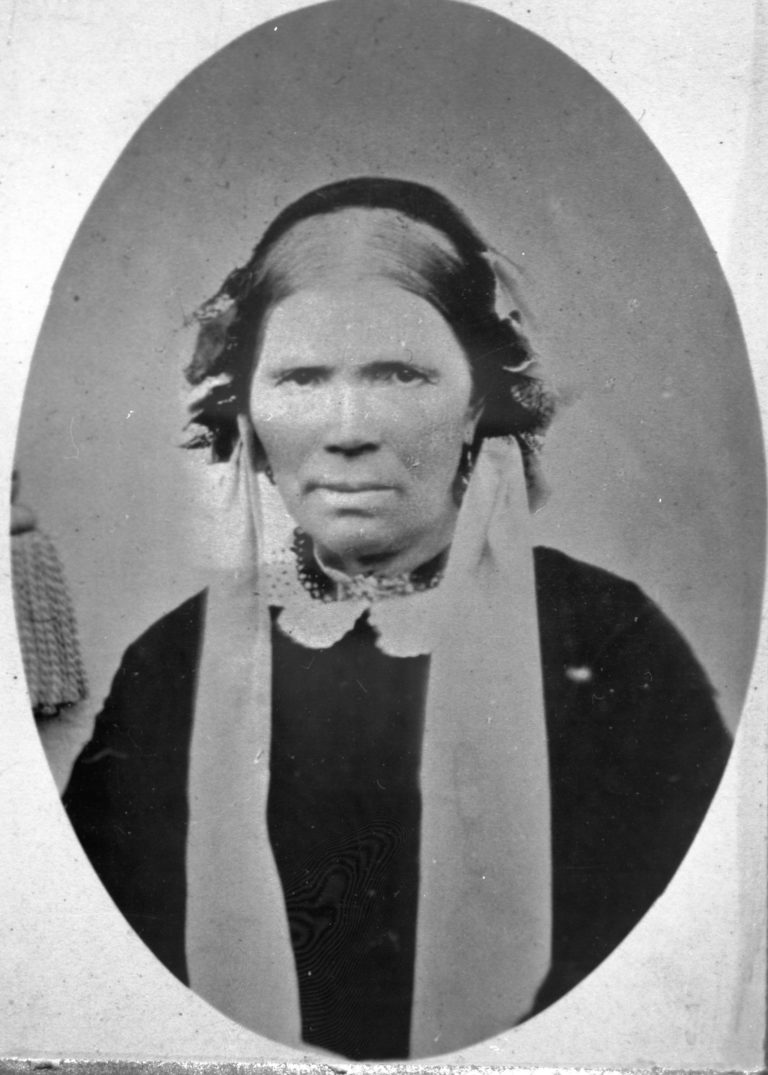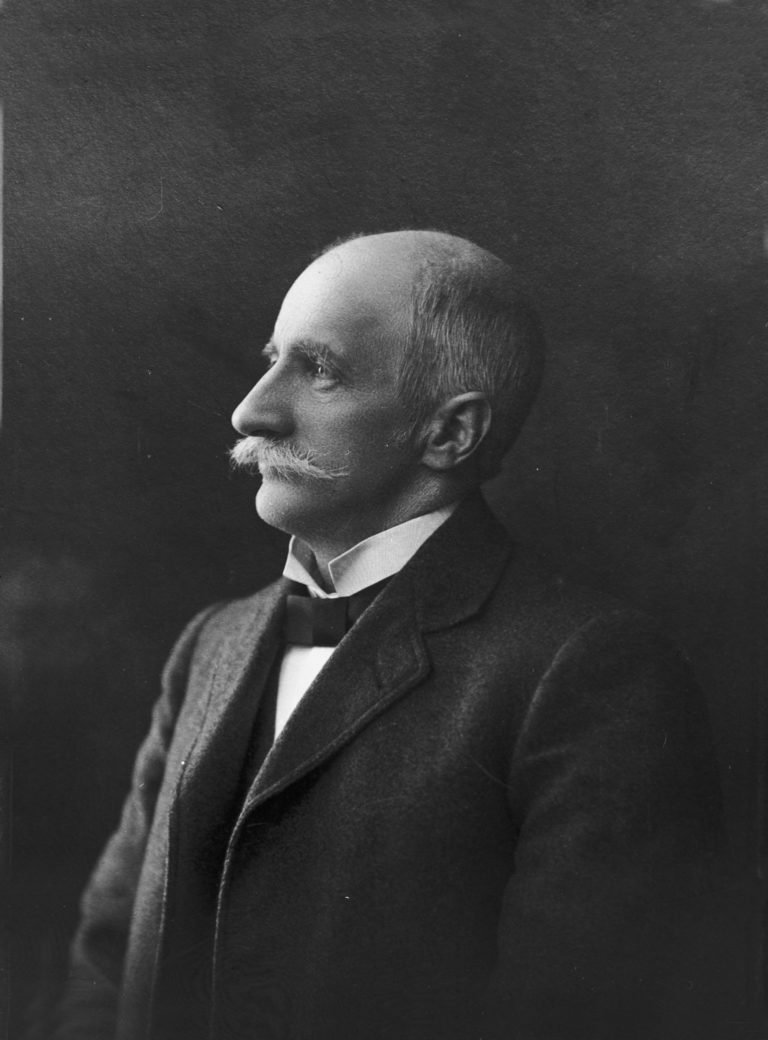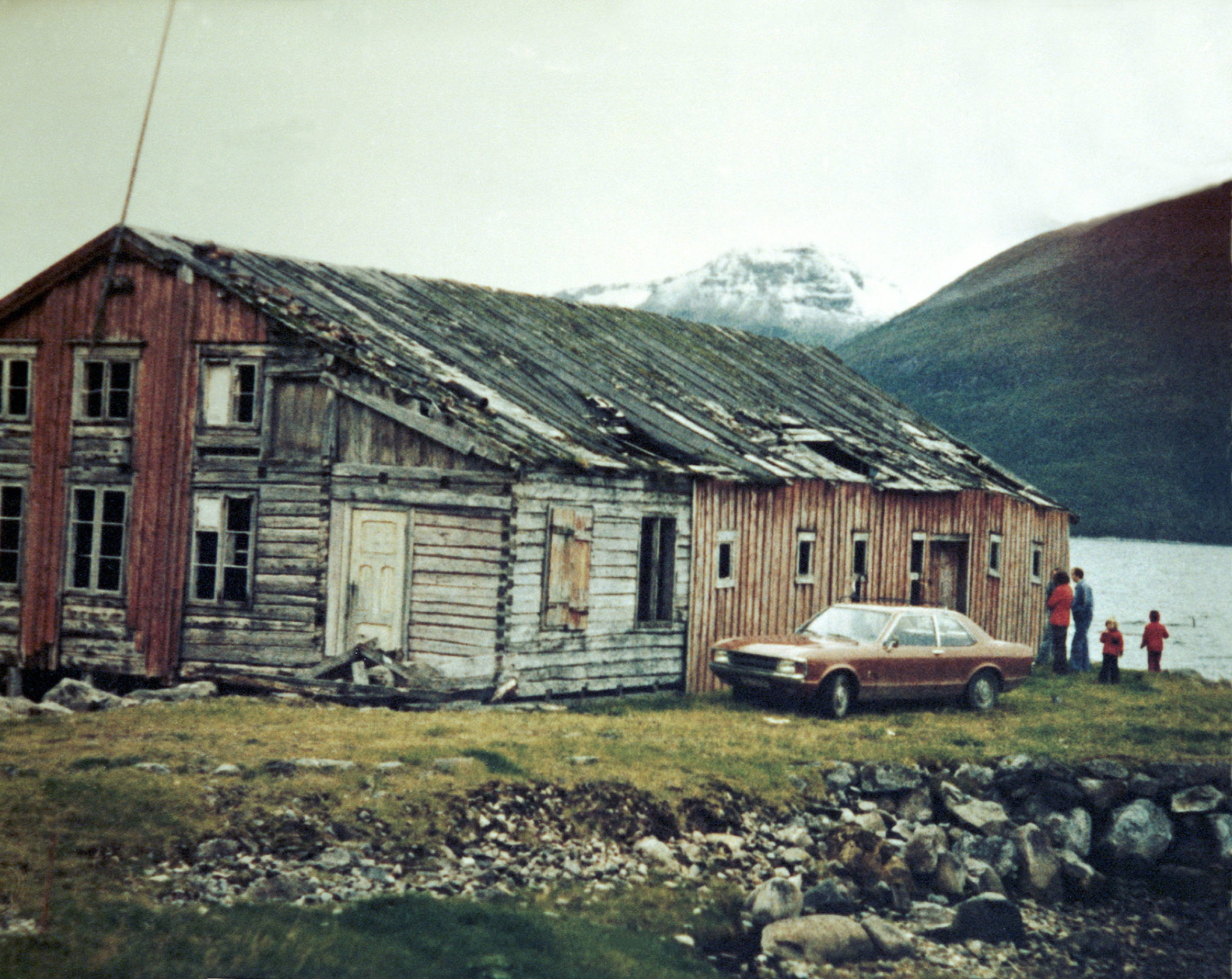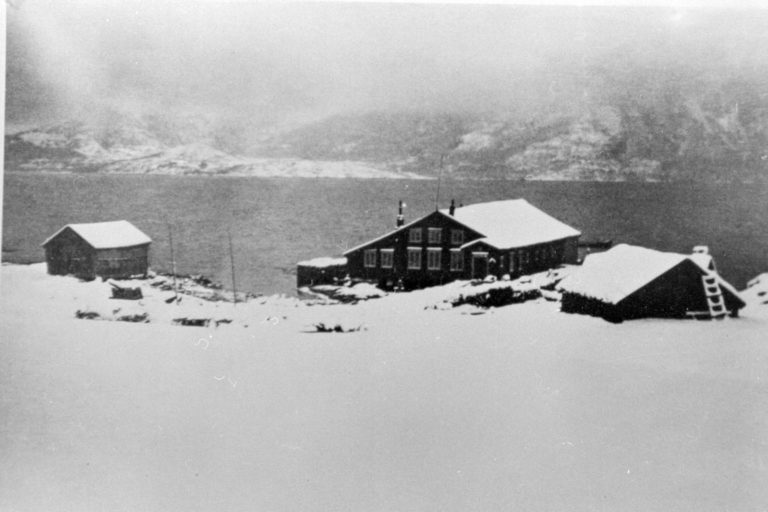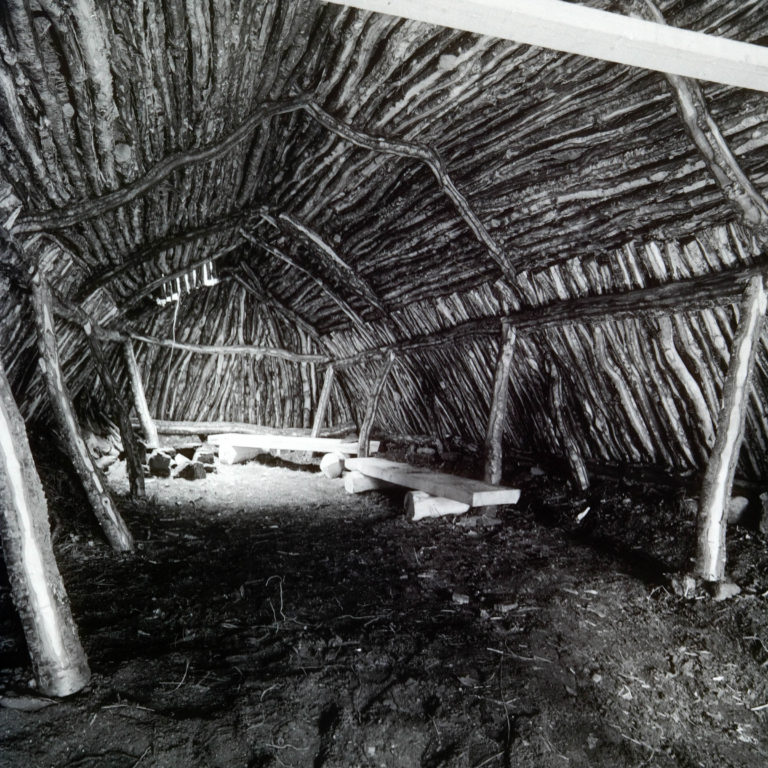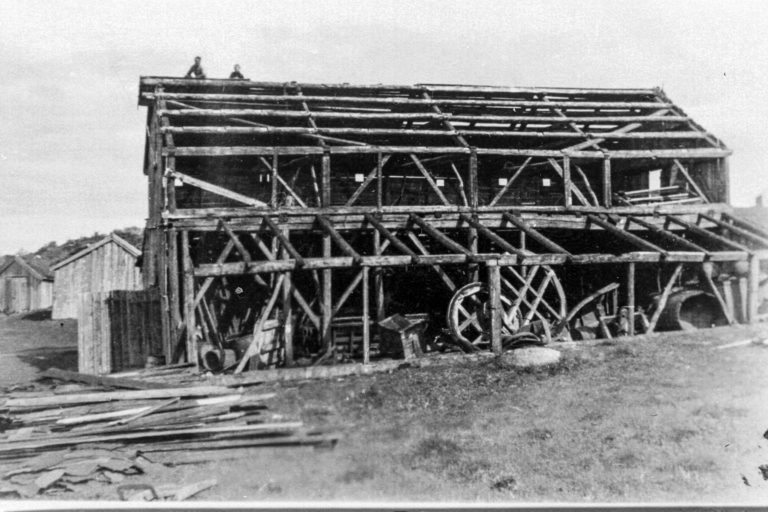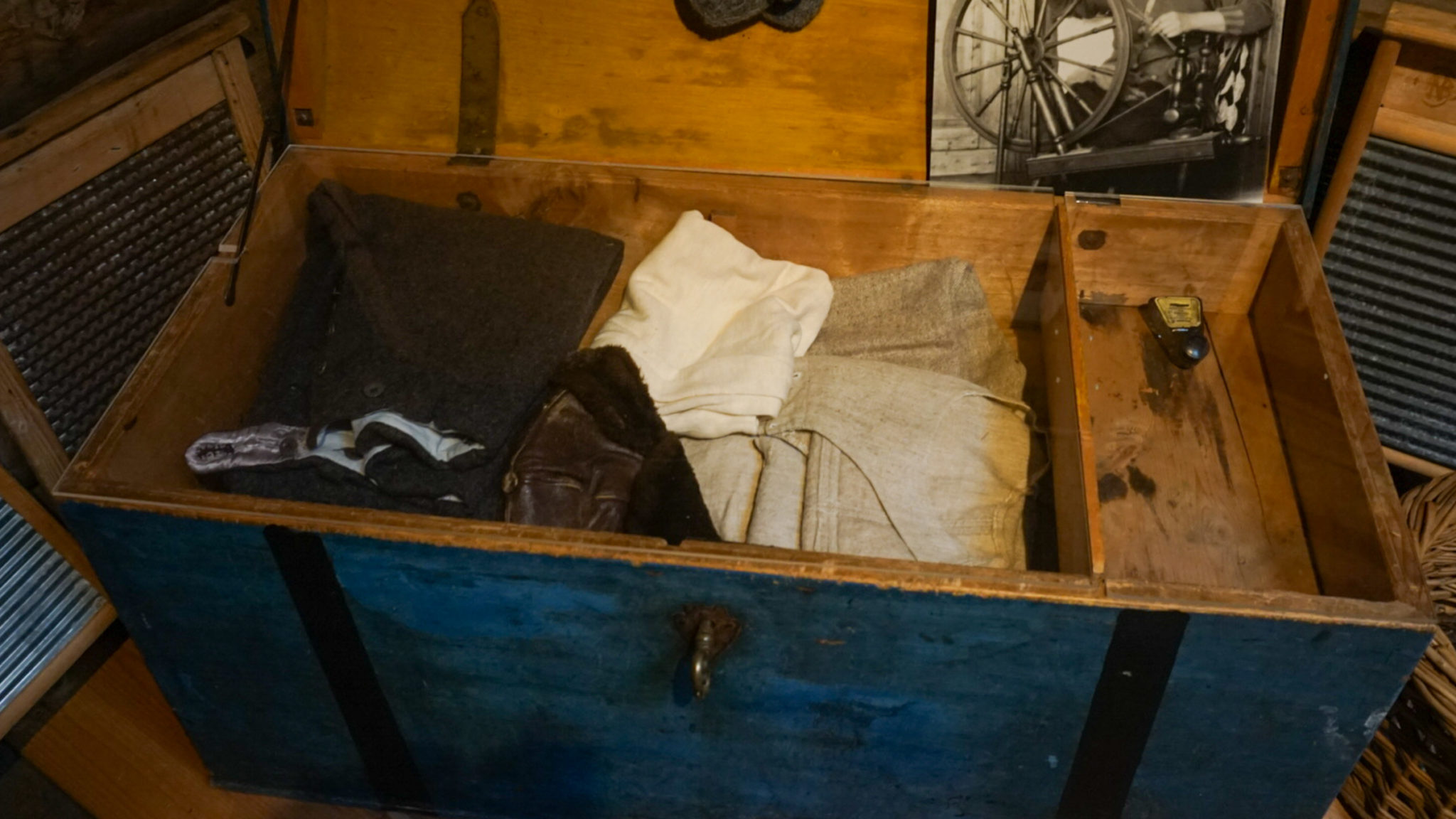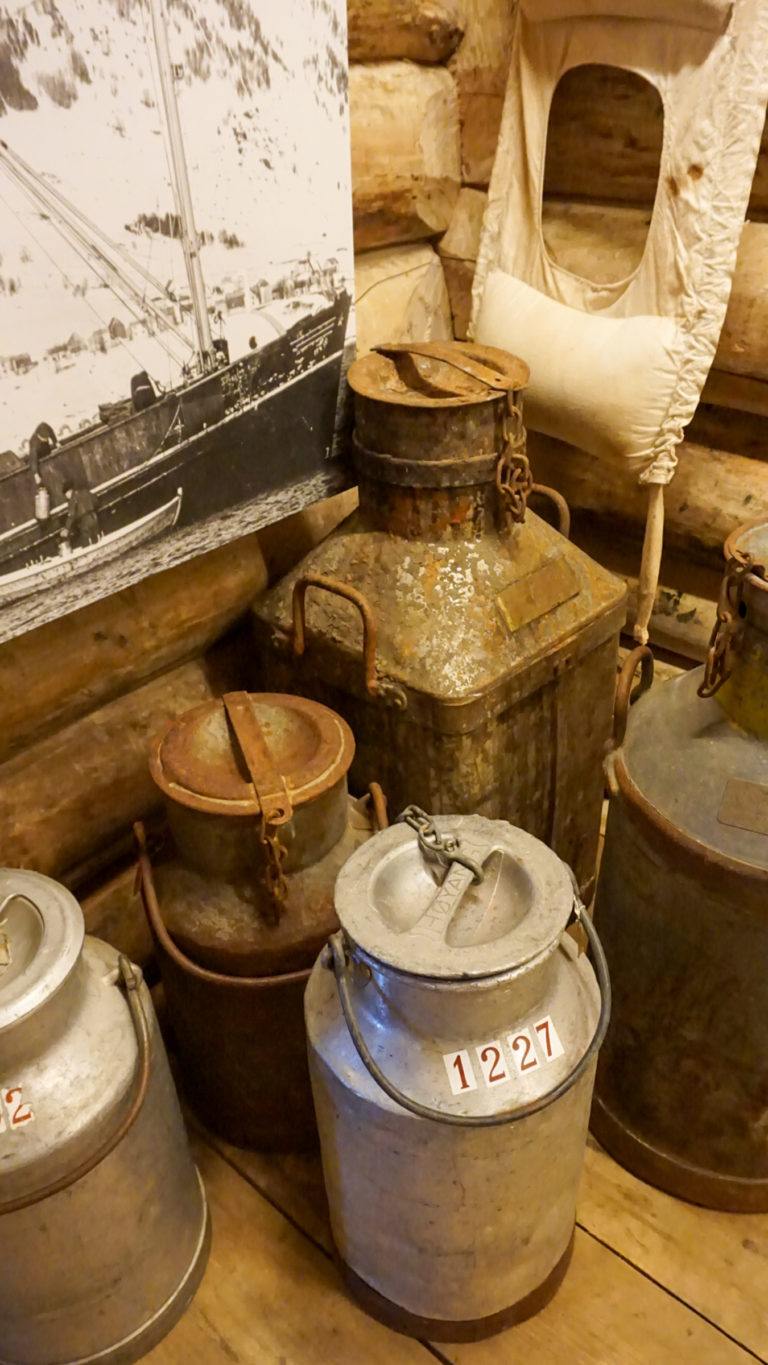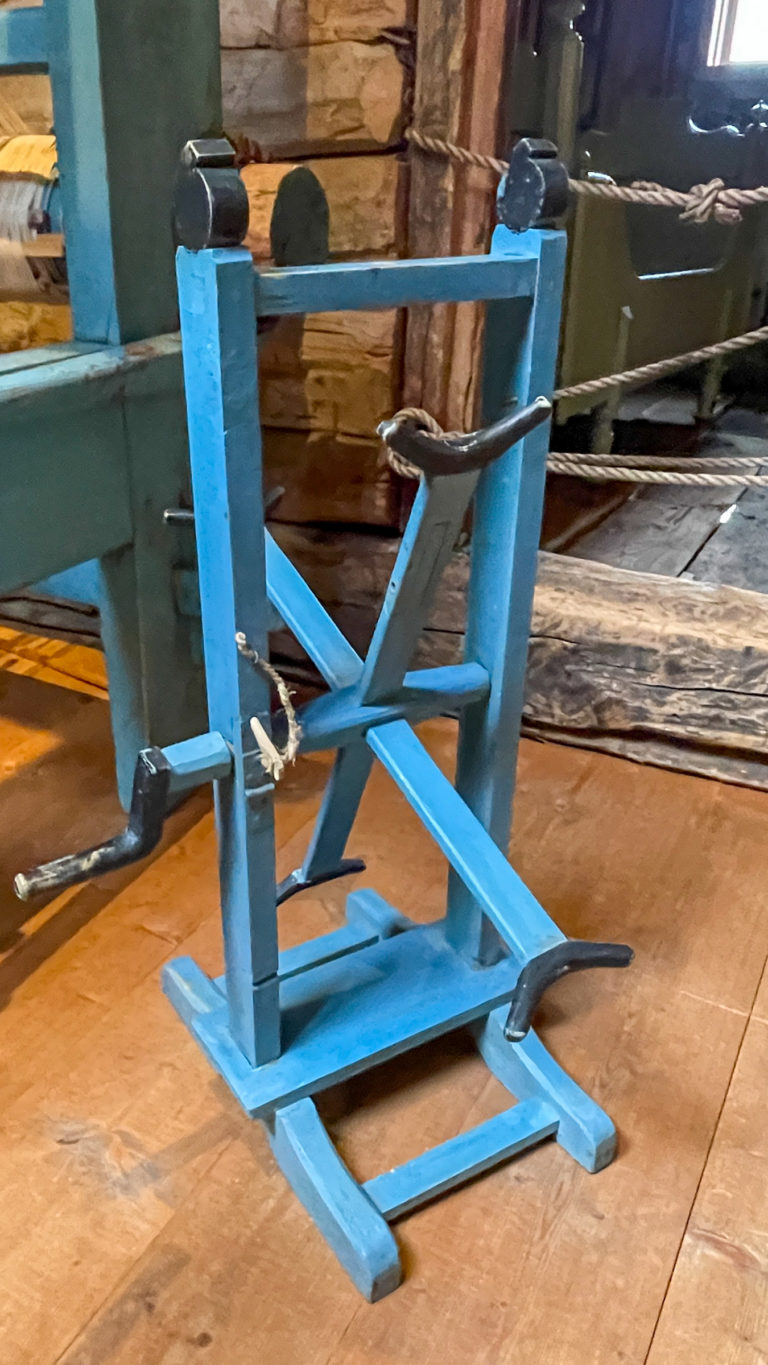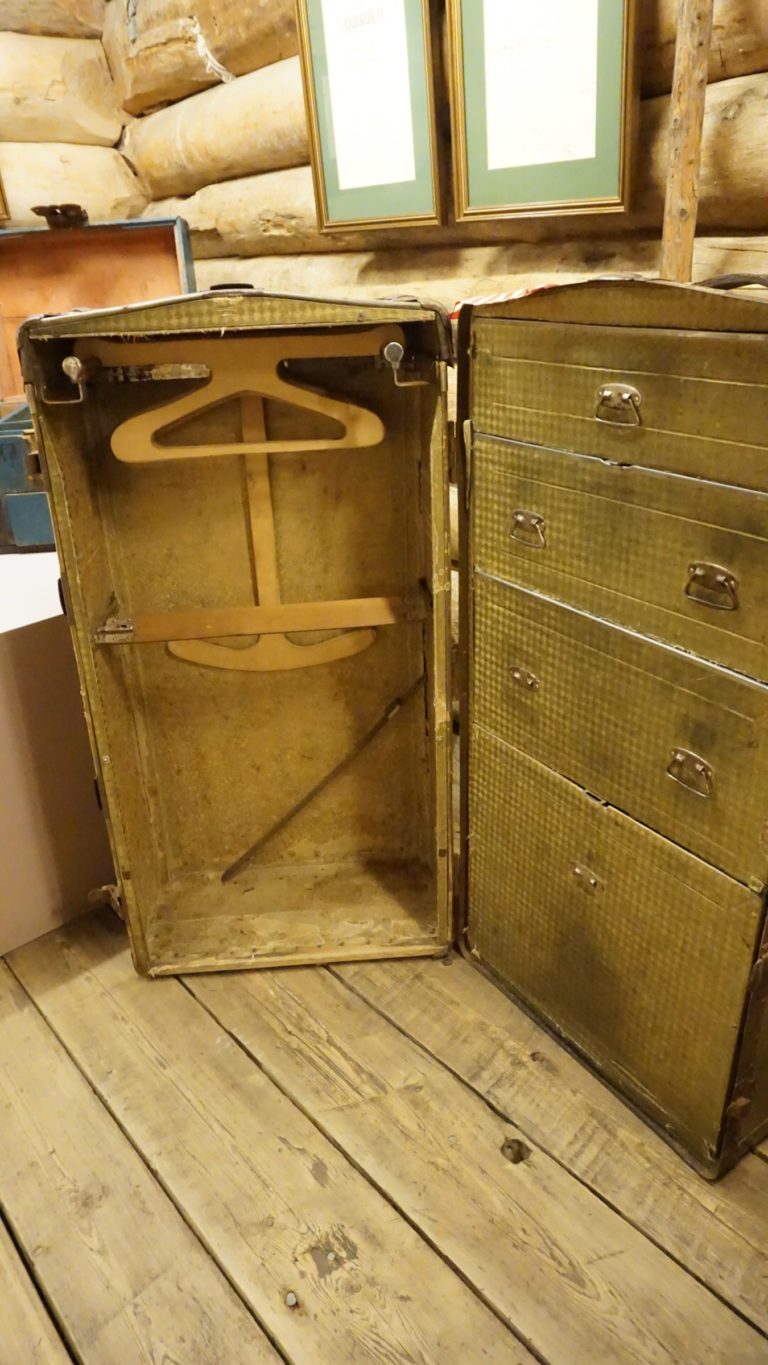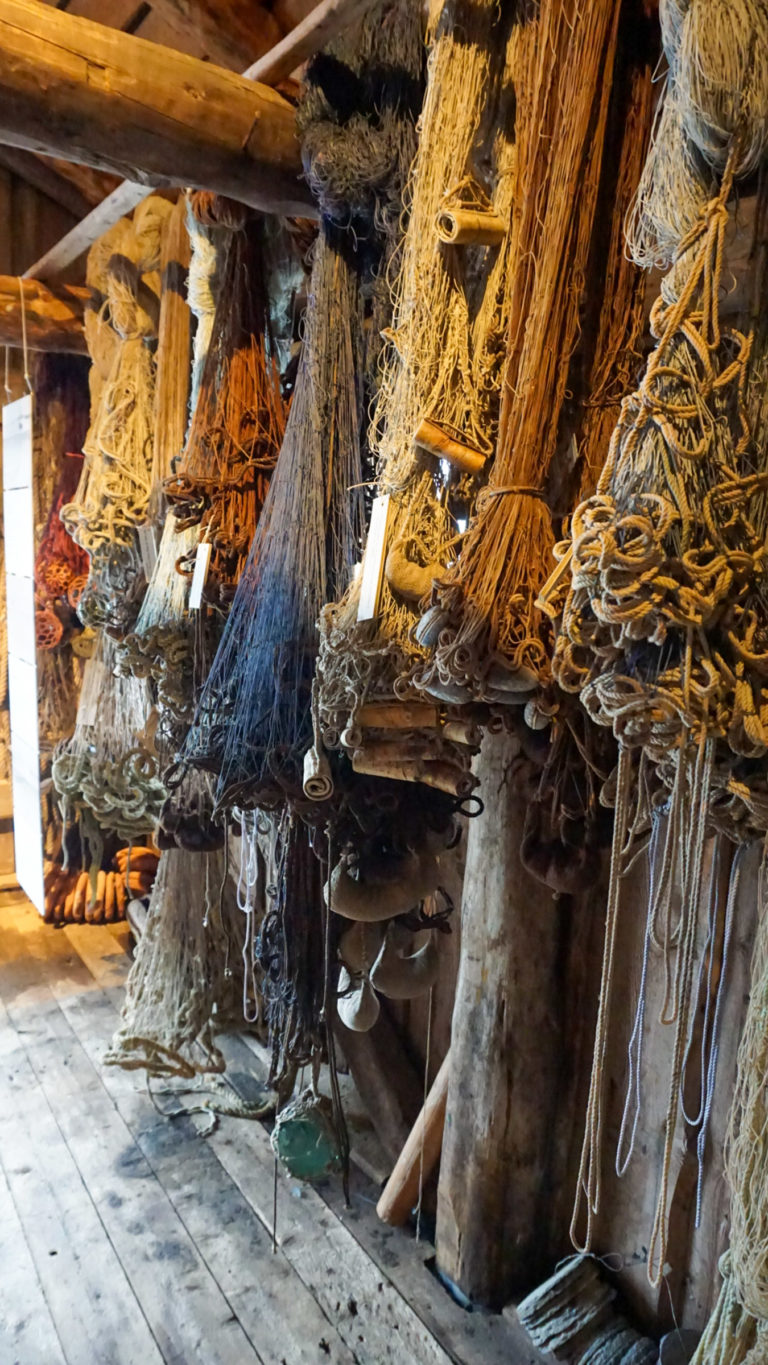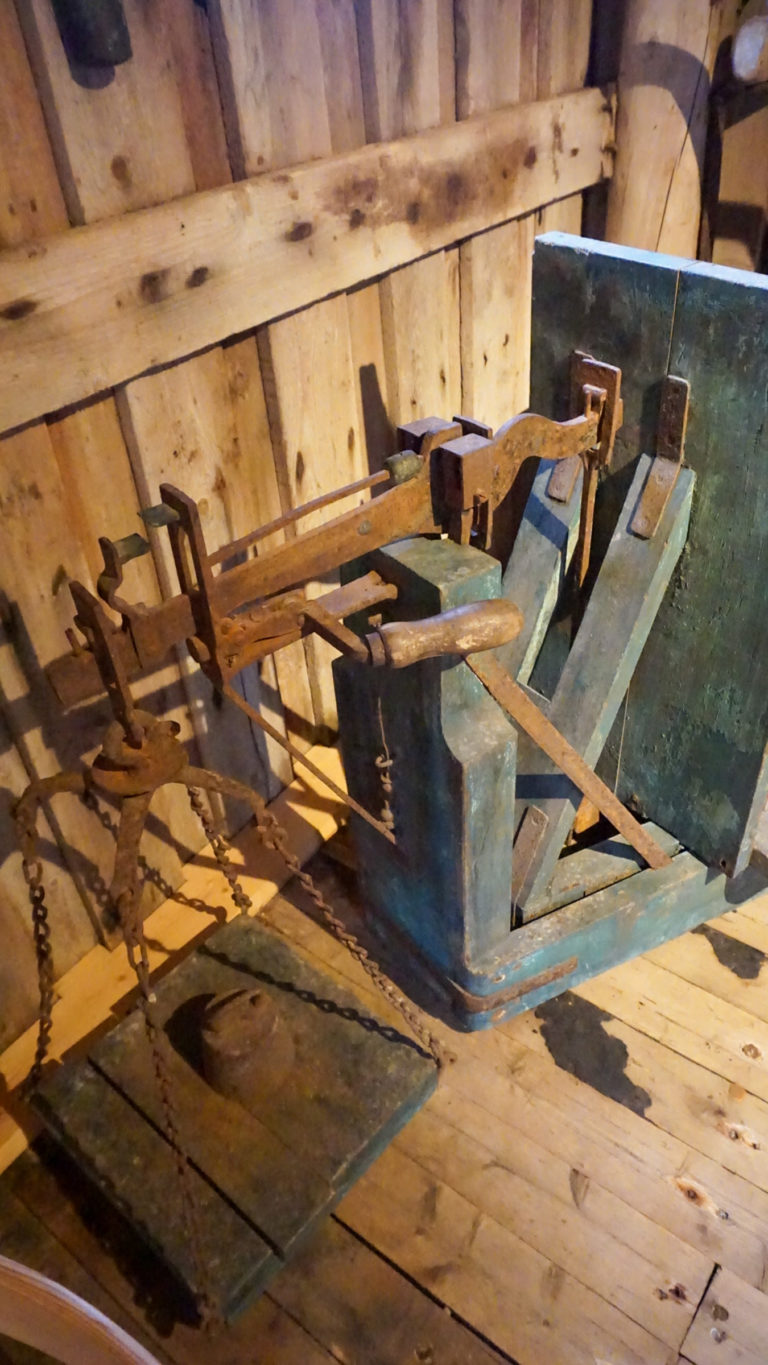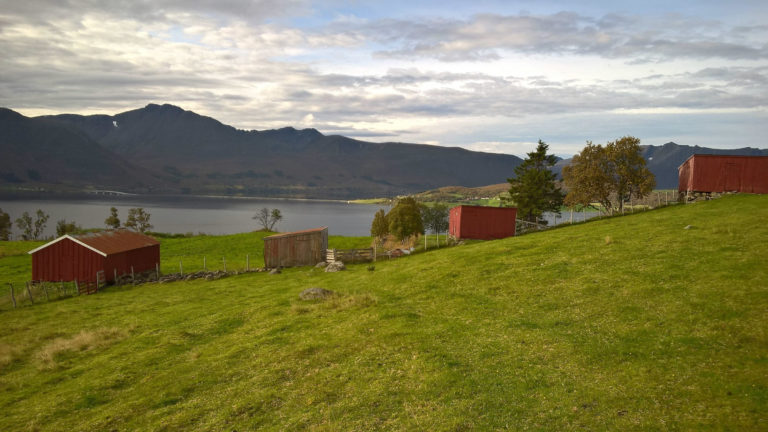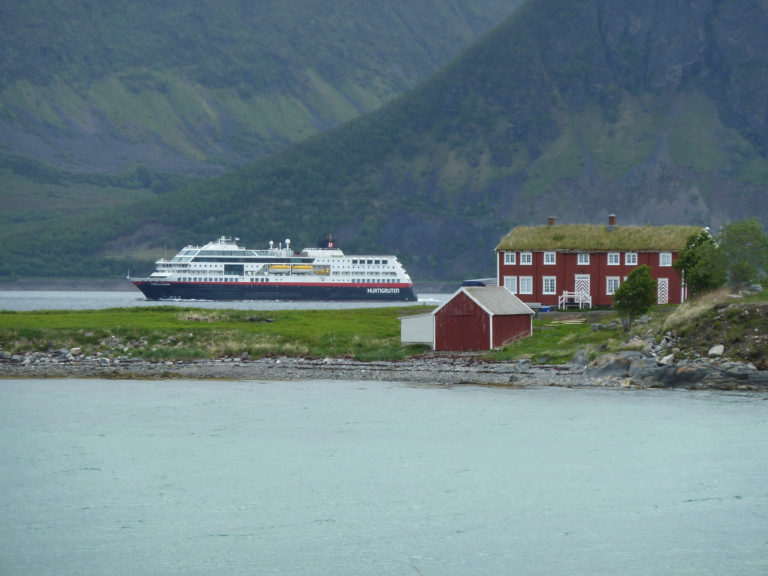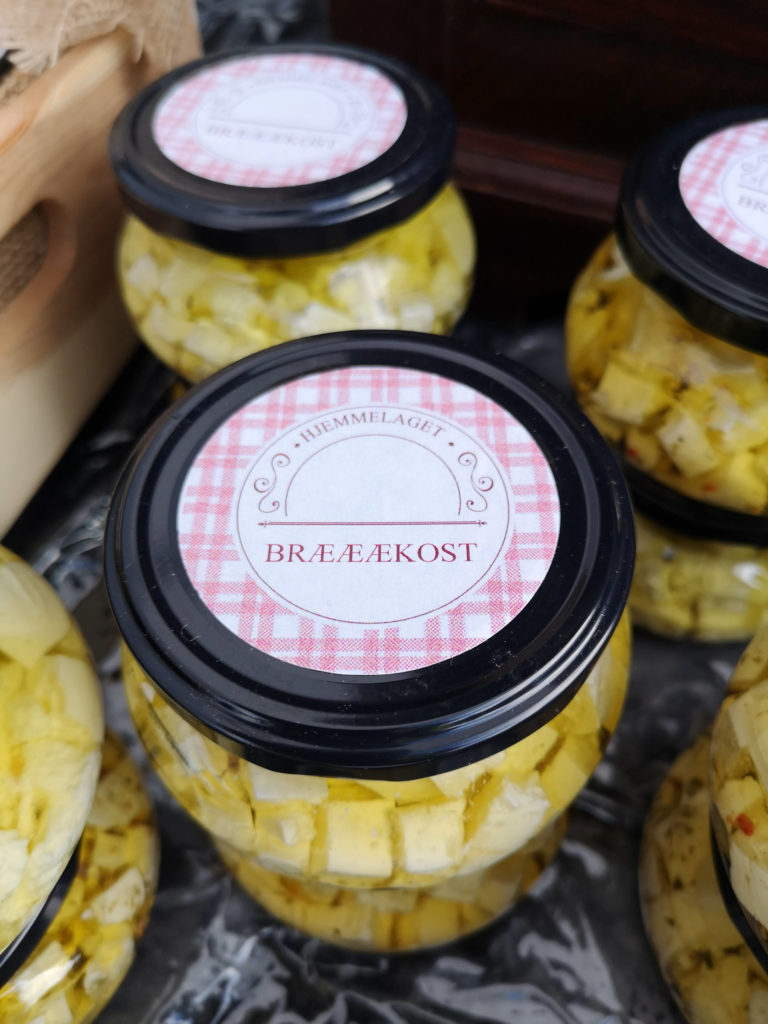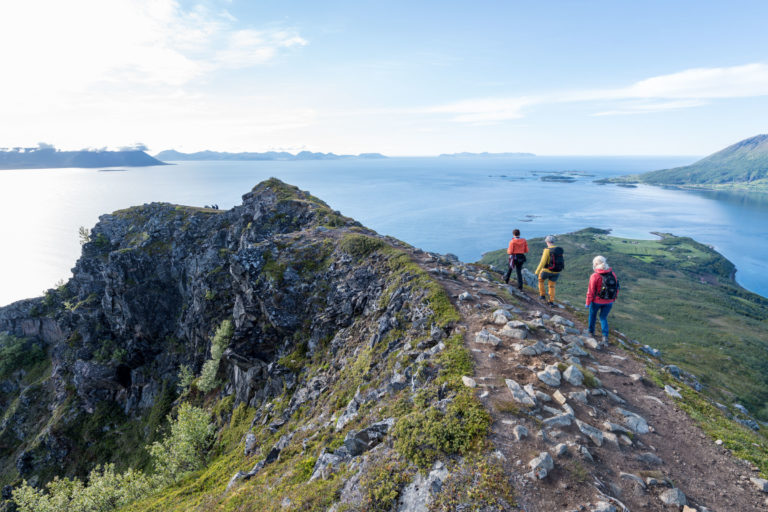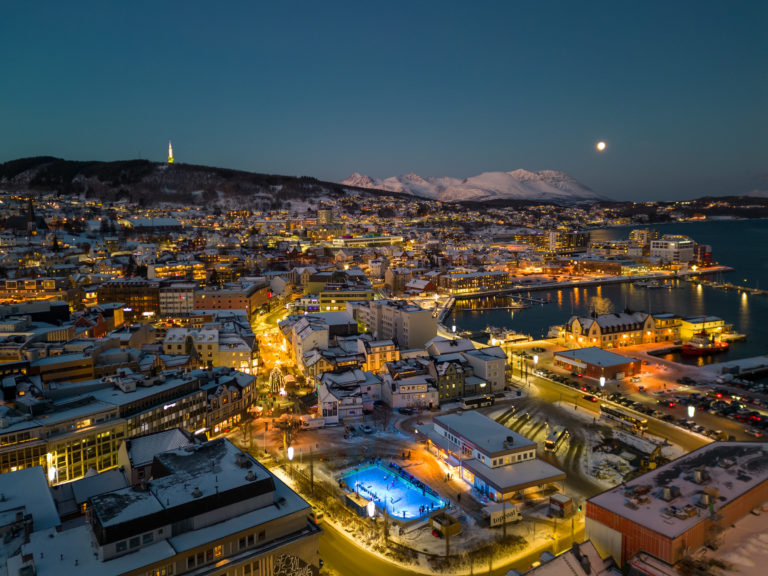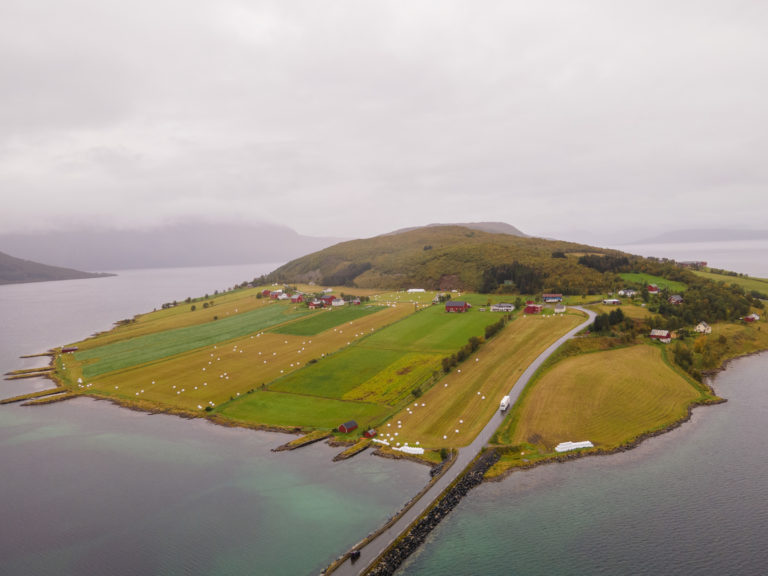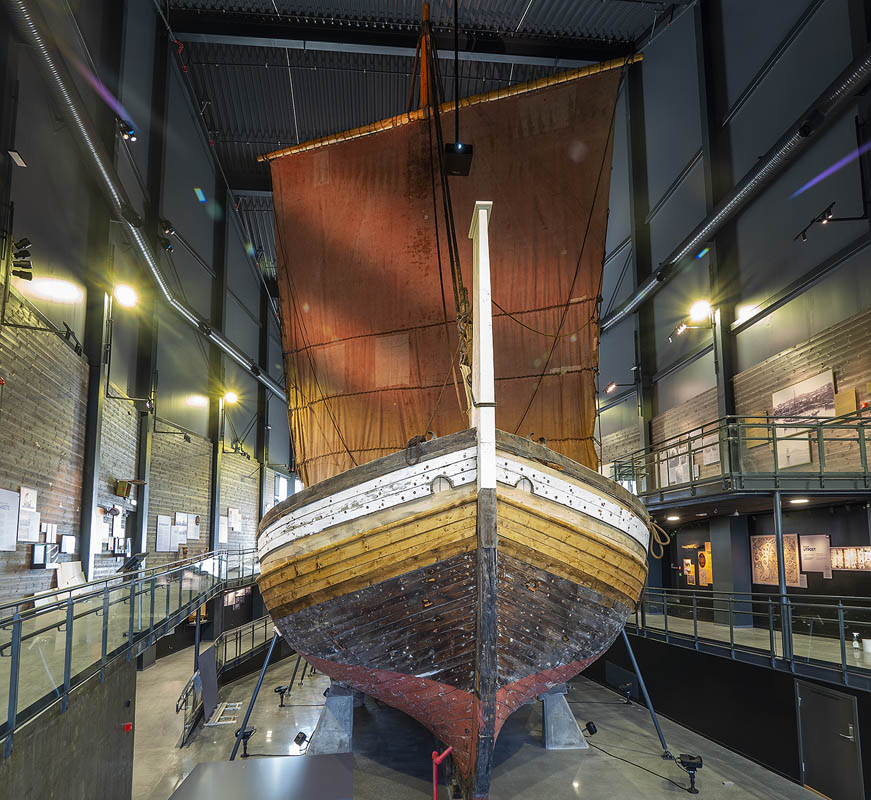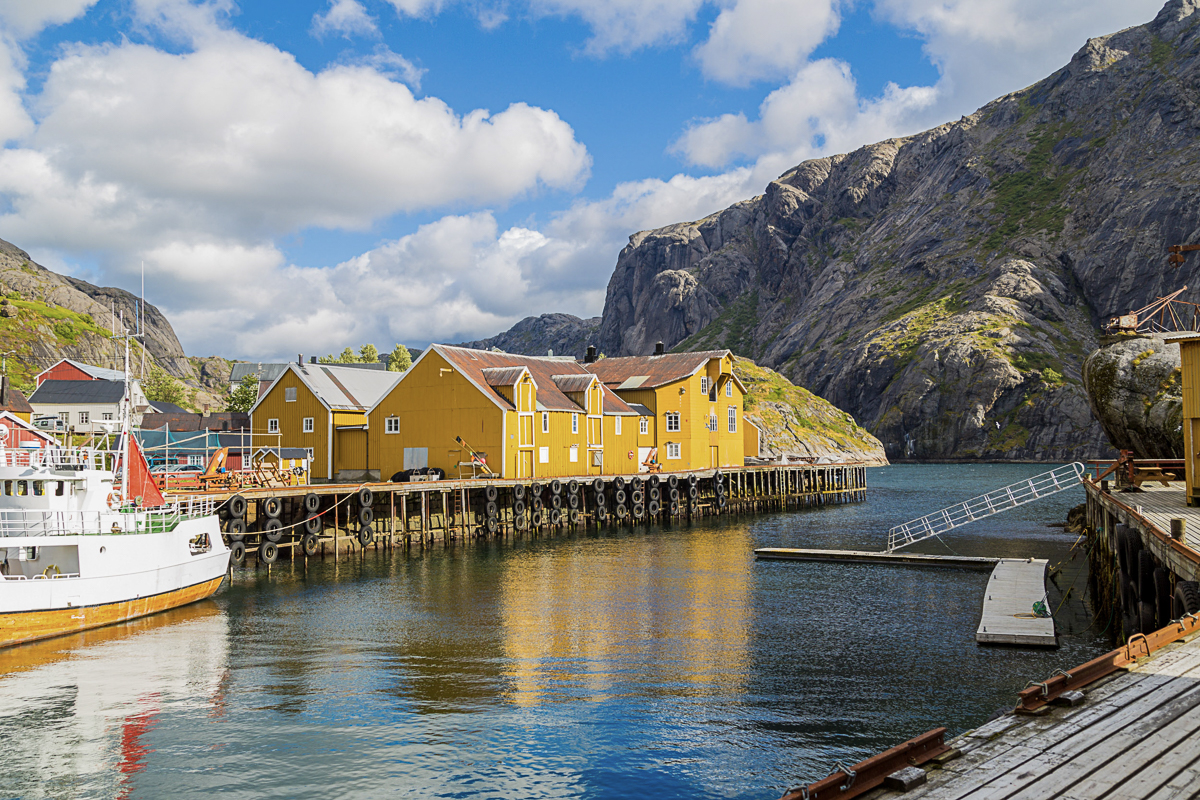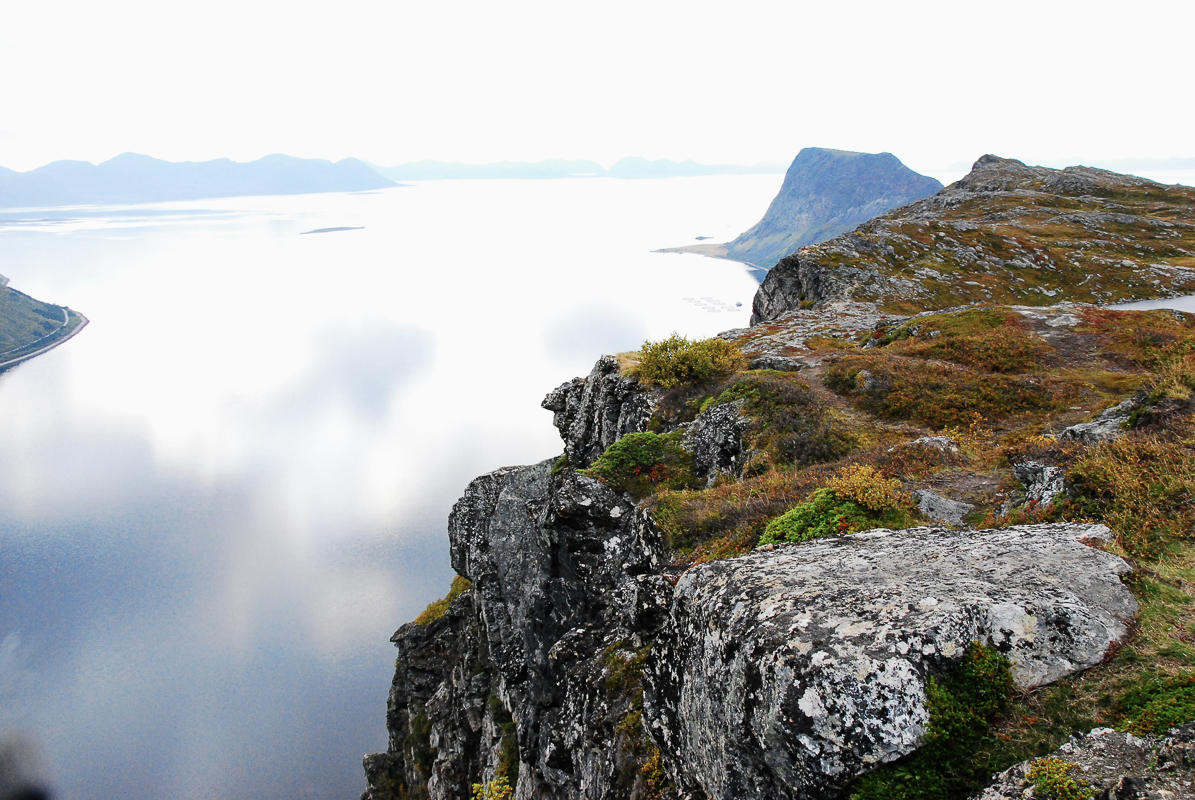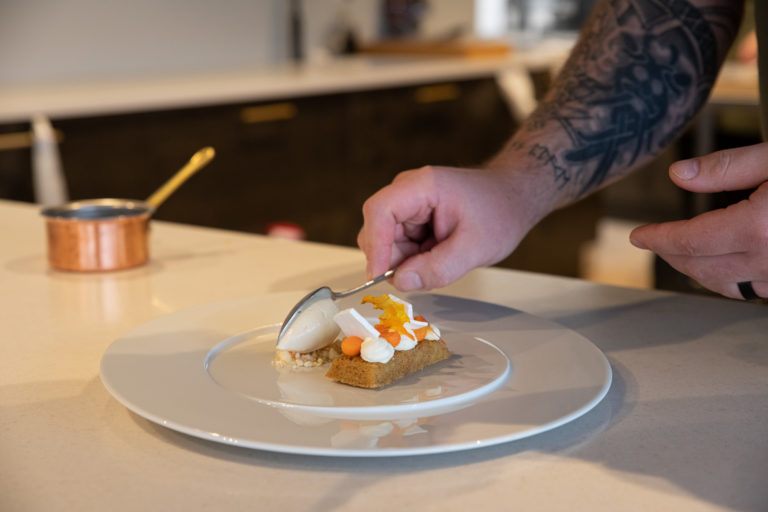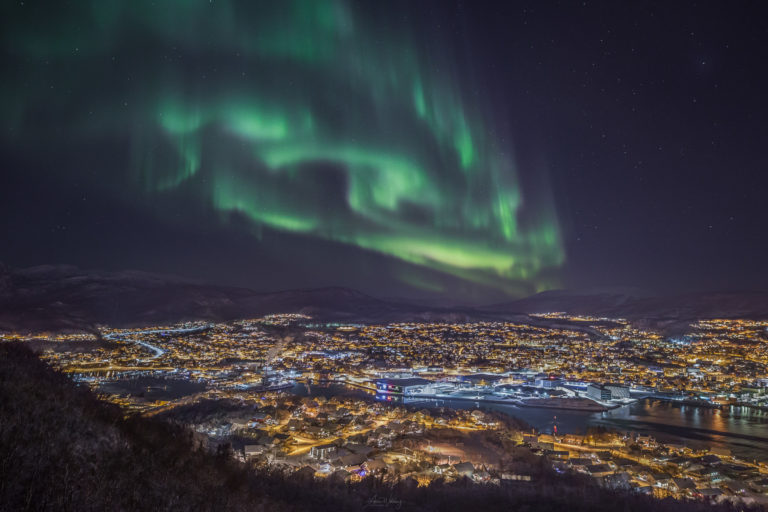I drove along Kvæfjord – the garden of Northern Norway – and admired the lush, green fields, the well-tended farms and the view across the calm fjord, with peaks dissolving softly into heavy clouds.
And there, on a promontory in the fjord, the Hemmestadbrygga warehouse invited me to a visit. Ochre and built on stilts, it has a commanding position on the fjord, with short rowing distances to everywhere that mattered 150 years ago. I knocked on the door with reverence.
The shop takes you back in time
Imagine a little boy from a modest smallholding 150 years ago entering the wonderful world of the general store; buckets hanging down from the ceiling, the smell of coffee, leather and spices and the odd toy – albeit beyond his parents’ means – displayed in one of the shelves. It must have been a wonderful glimpse into a wider world.
This blasé time visitor from the 21st century could relate to that emotion, being set back to 19th-century fishing and farming culture. Functioning as a shop all the way to 1954, the shop is still a colourful and sensory welcome to the museum.
I wandered along the shelves, cups, colourful biscuit tins and advertisements posters bringing back memories of visits to grandma.
Shopping lists tell stories
In 1862, the vicar of Kvæfjord sent a long shopping list from Bergen through Hemmestad, including spices like allspice and cloves, bottles of claret, sherry, and port, as well as sweet delights like chocolate and kringler – pastries – and impressive quantities of grain, among other items.
The modest fisherman at Gapøy went for a couple of barrels of rye and barley, a good kilo of molasses and two bottles of wine. One can easily imagine the dinner table at Gapøy being vastly different from the vicarage’s, just by reading the displayed shopping lists in the store.
A brygge was an economic hub in the fjord
In the north of Norway, a brygge is a warehouse built on stilts over the water. Boats could then load and offload on the fjord side, and goods could be stored. Local fishermen could deliver tørrfisk – dried cod – for transport to Bergen. In the latter half of the 19th c., the unpredictable herring would suddenly appear, creating a bonanza for a few years, before moving somewhere else.
The trader at Hemmestad would then export the fish to Bergen on a jekt – a bulky cargo ship – and bring back flour, sugar, coffee and frivolous indulgences like confectionery, wine, fine shoes and exotic spices.
Fish was – and is – the big commodity
Trade in Northern Norway was complex in previous centuries. The merchants in the cities, first and foremost Trondheim and Bergen, had a monopoly on buying the valuable fish and selling necessities like rye and barley, luxuries like coffee and spices, and temptations like strong liquor. However, burgesses – residents of the cities of Bergen and Trondheim – would come north in the summer to sell import goods to the northerners.
In 1566, there is mention of Nils Trondhjemsfar (“Trondheim farer”), peddling his goods from Hemmestad. On this promontory, people could come to him from around the fjord to trade.
Hemmestad becomes a year-round trade centre
In the late 18th century, a certain Gregus Jakobsen was selling spirits illegally, and was arrested for it in 1786. By 1798 he was a year-round resident and merchant with trading rights. He was operating a gjestgiveri – a trading post with an obligation to house people of note – rich traders and civil servants – when travelling. By the early 19th century, Hemmestad was the hub of activity in Kvæfjord, sending multiple jekts to Bergen each year.
The farm is uphill – the brygge is down at the fjord
The farm is, then and now, up the hill with several houses. Down at the promontory, the brygge itself dates from the late 18th century. There was also Stornaustet – the big boat house – and a tørkesjå – a shack for keeping dried fish and a number of other buildings. Today, the tørkesjå has been restored, but the others have since disappeared. In 1889, a post office opened inside the brygge.
Hemmestad was eventually left behind by time
By then, however, Hemmestad was slowly losing in the competition. Jekts were too slow for new times, and Hemmestad’s harbour was too shallow for the newer steamships. The city of Harstad and the ports of call of the Hurtigruten were better positioned to trade in fish. When the motorboat arrived, common people had a greater range of action and could trade over larger distances.
People in Kvæfjord concentrated more on agriculture, growing potatoes for sale. In 1904, Hemmestad went bankrupt, and was reduced to a local store. The farm on the slope remains one of the larger farms in Kvæfjord, but the hustle and bustle has long since moved elsewhere.
The old storage is full of exhibits
From the shop, I entered the spacious storage, where stockfish once would be stacked in high piles, awaiting transport on a jekt to Bergen. The smell of fish long gone; this is where you find exhibits about local themes. The texts are short and to-the-point. They are accompanied by old photos and lots of historical treasures, from a milk separator to old maps and Russian bark imported to isolate turf roofs. And much more.
Many people were attached to the farm
From Hemmestad, the opposite shore of the fjord is close. In summer, cows and sheep were taken across for grazing. The livestock would be kept in a summer barn, and every morning and evening, one or two dairy maids would row across the fjord to let the livestock out of the barn in the morning and milk them and lock them in in the evening.
There were also crofters – tenant farmers – leasing their land from the trading post. Little money was available, so they paid the lease by working on the main farm during the busy seasons. Young girls learned to take care of the house working long hours as maids. Teenage boys learned crafts and trading skills working as apprentices and helpers.
Women kept it all together
An exhibit is dedicated to the world of women. While the men were out fishing, the women took care of the farm. Women’s responsibility included the children, tending the livestock every day, taking care of the dairy production and acting as the main farmer in the summer.
In dark autumn evenings, the spinning and carding of wool kept women up long. Then the yarn was knitted into warm woollen garments and put in the lofotkista – the chest the menfolk would bring with warm clothes and other necessities when being away for 2-3 months. The men would typically be away long in the big seasonal fisheries in Lofoten and Finnmark.
What if the draug is calling your name?
Life close to nature meant spending a lot of time in utter darkness. And then you would hear things you couldn’t explain. This led people to believe in supernatural beings on land and at sea.
The scariest of them all would be the draug – a ghost-like figure, sailing in half a boat, face hidden and body in decay and dissolution. If he called your name out at sea, it meant your days were numbered.
Altogether more sympathetic is the marmæl, a little man that could come onboard your boat attached to the nets. Put him in your mitten and treat him well, and he could foresee the weather for you, or tip you off on where to fish. Meeting the marmæl was considered a stroke of luck.
The sea monster Kraken, on the other hand, could suddenly rise from the sea and lift even big ships.
A variety of themes are on display
The well-explained exhibits touch on a variety of themes. In the early 1860s, large shoals of herring migrated into Northern Norwegian waters, creating an economic heyday in the north. Fishermen could make fortunes and people were hired in the new fish processing plants. However, the herring would stay in one location for a few years before moving elsewhere.
Kvæfjord is well known for growing potatoes in the favourable climate, a special potato fork was even developed here. Even Kvæfjord’s strawberries are mentioned.
Finish off with a heavenly cake
In summer, there is also a little café inside the brygge. This is an excellent chance to try the local cake favourite, the kvæfjordkake, a dream of meringue, almonds and whipped cream. Voted “Norway’s national cake” by listeners of Norwegian radio’s most popular morning show, it is a delight that should not be missed.
Their fish soup is the lunch favourite. The nearby Refsnes Matglede – an informal café with many friends – delivers the food. Otherwise, filter coffee by the buckets, waffles and good banter are key ingredients to the stay. Hemmestadbrygga is a popular local excursion destination.
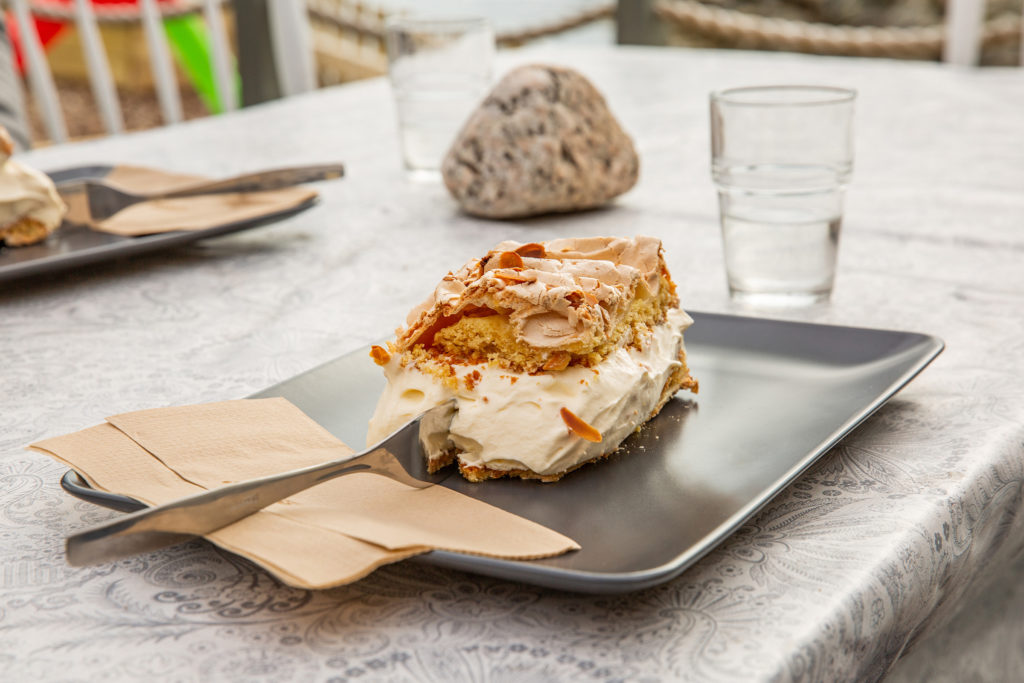
Getting to Hemmestad and other practicalities
Hemmestad is a hamlet along the Kvæfjord, in the southwestern corner of Troms county, a good half an hour’s drive from Harstad, and but a few kilometres from the ferrydock of Revsnes (occasionally spelled Refsnes) on highway 83. Sortland in the Vesterålen Islands is a good hour and 45 km west of Hemmestad, although travelling time will depend on the Gullesfjord ferry (Revsnes-Flesnes) departures. Svolvær, at the eastern end of the Lofoten chain, is about 2,5 hours and 116 km southwest of Hemmestad.
The museum has extensive opening hours in the main summer tourist season. Check their website for more info
Kvæfjord is known for its rich agriculture. Read our article on local food, and maybe stop by some of the local food producers mentioned. The culture path Skallan-Rå is an easy walk between culture and nature with great views. More challenging tours are mentioned in our Harstad hiking article.
Visit Harstad covers the Harstad-Kvæfjord region. For more about the Vesterålen islands in the west, consult Visit Vesterålen. Visit Lofoten is the place to start when it comes to the Lofoten islands.

